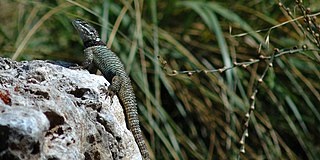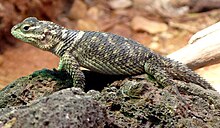
The eastern copperhead, also known as the copperhead, is a species of venomous snake, a pit viper, endemic to eastern North America; it is a member of the subfamily Crotalinae in the family Viperidae.

The greater earless lizard is the only species in the monotypic genus Cophosaurus. It is closely related to the smaller, lesser earless lizards and other species in the genus Holbrookia, and in fact was placed in that genus and referred to Holbrookia texana from 1852 into the 1970s. Earless lizards lack external ear openings, an adaptation to burrowing in the sand, as are the recessed lower jaw and flared upper labial scales. Greater earless lizards are sexually dimorphic, males grow larger and are more colorful than females, exhibiting pink and green colors that are particularly bright in the breeding season. Two bold black bars mark the lateral region of males but are greatly reduced and vague, or occasionally entirely absent in females.

Spiny lizards is a common name for the genus Sceloporus in the family Phrynosomatidae. The genus is endemic to North America, with various species ranging from New York, to Washington, and one occurring as far south as northern Panama. The greatest diversity is found in Mexico. This genus includes some of the most commonly seen lizards in the United States. Other common names for lizards in this genus include fence lizards, scaly lizards, bunchgrass lizards, and swifts.

The granite spiny lizard is a species of lizard in the family Phrynosomatidae.

The Mediterranean house gecko is a species of house gecko common to the Mediterranean area which has spread to many parts of the world. It is commonly referred to as the Turkish gecko as represented in its Latin name and also as the moon lizard because it emerges in the evening.

The Texas alligator lizard is a species of lizard in the subfamily Gerrhonotinae of the family Anguidae. The species is endemic to the central region of the American state of Texas, and south into adjacent northern Mexico.

The northern sheep frog is native to Central America, Mexico, and extreme south Texas, United States. It occurs in the lowlands from Sonora, Mexico, to northern Costa Rica on the Pacific coast, and south Texas to Honduras on the Gulf of Mexico and Caribbean coasts. The sheep frog inhabits semiarid thornscrub, savannas, pasturelands, and open woodlands, as well as more humid, moist forest in the canyons, basins, foothills, and lower elevations of mountains slopes. It is a fossorial, burrowing frog that is seldom seen on the surface except at night after heavy rains when they emerge to breed. The sheep frog gets its name from its distinctive call that resembles a sheep's bleat. It is a diet specialist primarily feeding on termites and ants.

Ctenosaura pectinata is a species of moderately large lizard in the family Iguanidae. The species is native to western Mexico.

Holbrookia maculata, commonly known as the lesser earless lizard, is a species of lizard in the family Phrynosomatidae. The species is native to the southwestern and central United States and northern Mexico. There are eight recognized subspecies.

Sceloporus grammicus is a species of lizard from Mexico and the southern United States. It is sometimes referred to as the mesquite lizard or graphic spiny lizard.

Sceloporus merriami, commonly known as the canyon lizard, is a species of lizard in the family Phrynosomatidae. The species is native to the south-western United States and northern Mexico.

Sceloporus variabilis, commonly known as the rosebelly lizard, is a species of lizard, which is endemic to Mexico.

The Texas lyre snake is a species of mildly venomous rear-fanged snake in the family Colubridae. The species is endemic to the southwestern United States and adjacent northern Mexico.

Sceloporus merriami annulatus, commonly known as the Big Bend canyon lizard, is a subspecies of the canyon lizard, and is endemic to southwestern Texas and adjacent northeastern Mexico.
Hobart Muir Smith, born Frederick William Stouffer, was an American herpetologist. He is credited with describing more than 100 new species of American reptiles and amphibians. In addition, he has been honored by having at least six species named after him, including the southwestern blackhead snake, Smith's earth snake, Smith's arboreal alligator lizard, Hobart's anadia, Hobart Smith's anole, and Smith's rose-bellied lizard. At 100 years of age, Smith continued to be an active and productive herpetologist. Although he published on a wide range of herpetological subjects, his main focus throughout his career was on the amphibians and reptiles of Mexico, including taxonomy, bibliographies, and history. Having published more than 1,600 manuscripts, he surpassed all contemporaries and remains the most published herpetologist of all time.

Ctenosaura acanthura, is a species of iguanid lizard found in eastern Mexico and extreme western Guatemala. The standardized English name is the Mexican spiny-tailed iguana. Confusingly however, an earlier edition of standardized names for Mexican herpetofauna called Ctenosaura acanthura the northeastern spinytailed iguana and applied the name Mexican spinytailed iguana to Ctenosaura pectinata, which was called the western spiny-tailed iguana in the second edition. It has also been referred to as the Veracruz spiny-tailed iguana and Gulf Coast spiny-tailed iguana. It is an egg laying species that is mostly herbivorous and a moderately large lizard commonly growing over one meter in total length.

Sceloporus occidentalis bocourtii, commonly known as the Coast Range fence lizard, is a subspecies of Sceloporus occidentalis, the Western fence lizard.

Slevin's bunchgrass lizard is a species of lizard in the family Phrynosomatidae. The species is indigenous to the southwestern United States and adjacent northern Mexico.

Sceloporus jarrovii, also known commonly as Yarrow's spiny lizard, is a species of lizard in the family Phrynosomatidae. The species is native to the southwestern United States and northern Mexico. There are two recognized subspecies.

Sceloporus mikeprestoni, Preston's torquate lizard, is a species of lizard in the family Phrynosomatidae. It is endemic to Mexico.





















